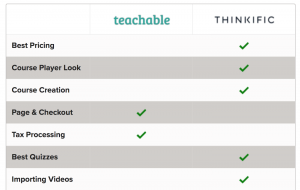If you want to grow your startup into a successful business, you’re going to need some customers. But building brand recognition is hard — especially when no one knows you exist.
Chances are, you don’t have a big enough budget to spend thousands of dollars on advertising, trying to convince cold prospects to care about what you’re selling.
So…how can you sell products and develop a loyal customer base when nobody has heard of you?
This question leaves a lot of entrepreneurs scratching their heads. But fortunately, there are multiple strategies you can try.
Today, I’ll show you one free option and one paid option.
Strategy #1: Get Free Traffic From Search Engines
For those who aren’t familiar, SEO stands for “Search Engine Optimization.” It refers to the art and science of writing great articles and getting them to rank on the first page of Google’s search results.
For example, if a person Googles “book marketing software,” and your article is the first result on Google, there’s a very good chance that person will visit your website, where they could potentially join your email list or even buy some of the products you’re selling.
How do I know this works? Well, I have a book marketing software, and search engine traffic has been my #1 sales driver since I founded my company a few years ago.
Here’s the big idea: No one is searching for your company, but they are searching for products like yours — in other words, your more established competitors. And by writing clever articles, you can steal some of that attention and start making sales.
Here are four types of articles that can help you do that.
“Best Of” Articles
Lots of people Google “best of” keywords.
Phrases like:
- Best shoes for runners (Googled by 53,000 people per month)
- Best sci fi books (Googled by 18,000 people per month)
- Best writing apps (Googled by 1,500 people per month)
- Best meal delivery service for single people (Googled by 250 people per month)
By doing some keyword research with tools such as AHrefs, you can find article opportunities like these that will allow you to naturally mention your own company.
And when it comes to writing the actual post, this article about the best writing apps is a great example to follow. Just imagine hundreds or even thousands of your ideal customers seeing your product at the top of a list like this.
Pricing Comparison Articles
If you have a low-cost product, or a product that is less expensive than some of your biggest competitors, you might want to write a pricing comparison article.
Just like “Best,” “Cheapest” is another popular search term on Google:
- Cheapest flights (Googled by 116,000 people per month)
- Cheapest car insurance (Googled by 35,000 people per month)
- Cheapest gaming laptop (Googled by 5,300 people per month)
There are literally thousands of examples, and there’s a good chance one of these searches will give you the chance to talk about your own product.
The key to writing a good pricing comparison article is making all of the hidden fees obvious, ranking the products accordingly, and pointing out value over fancy features.
This Food Delivery Guru article about the cheapest meal kits and prepared meal delivery services is a great example to follow. It gives a quick snapshot to get people started and then goes into more detail on each service. It also breaks out shipping fees, which impact which meal delivery service is really the cheapest.
Head-to-Head “Versus” Articles
Another common keyword searched on Google is “vs”.
If you have more than one popular competitor, you should see if your target customers are Googling versus-style keywords like:
- BirchBox vs Ipsy (Googled by 3,800 people per month)
- Constant Contact vs Mailchimp (Googled by 4,100 people per month)
- Mac vs PC (Googled by 8,300 people per month)
Here’s a versus article I wrote about the eCourse creation platforms Teachable and Thinkific you can reference as an example.
While you’ll want to give searchers what they’re looking for (a comparison of the two original services) you can still use versus articles as an opportunity to talk about your startup.
For example, in the table below, you could add a third column with your own product, showing why it might be better.

Review Articles
Reviews are another opportunity to talk about your startup.
Now, you’re probably thinking, “No one is searching for reviews of my product because no one knows it exists!” And I totally get that, but readers are searching for reviews of your competitors. And, believe it or not, you can actually write articles about your competitors and use them as a chance to mention the advantages of your own products.
I recently wrote a review of the audiobook library Scribd that can serve as a great example of this. I go into detail about the Scribd service, but at the end of the article, I point out that some people might be better off with Audible or Kindle Unlimited. Now imagine if you had an audiobook streaming service. You could do something similar!
Who are your biggest competitors? Could you write a review of these services and mention your own tool along the way?
Strategy #2: Utilize Google’s Paid Advertisement Services
If your marketing budget allows it, using paid advertising such as Google Adwords can be an effective way to draw online attention.
Unlike many forms of online advertising, Google Adwords allows you to get in front of your target customer at the precise moment when they’re searching for a product like yours.
And unlike the free techniques we just discussed, Google AdWords allows you to target the same set of keywords without having to worry about SEO, which can take some time to do correctly.
Here’s an example:
In 2017, Dinnerly entered the meal delivery space as an affordable alternative to Blue Apron. Over time, Dinnerly became well-known for its $5 meals.
When EveryPlate launched over a year later, with the very same premise, they had to find a way to steal some attention from Dinnerly. And if you simply Google the words “Dinnerly review,” you might spot one of the ways they’re doing just that.
When I search for “Dinnerly review,” one of the first things I see is an ad for EveryPlate.

Ads like this can be very effective because convincing a person to switch from one low cost meal service to another isn’t nearly as hard as convincing a cold prospect to try one in the first place.
By targeting people looking for a Dinnerly review, EveryPlate is able to tug people toward their own product.
Do’s and Don’ts of Google AdWords
Just because Google does most of the work for you doesn’t mean that you don’t need to pay attention to your ad campaigns. Here’s a quick list of things you should do/avoid to ensure your best experience.
Don’t treat your Adwords with a set-it-and-forget-it mentality.
Google ad campaigns require care. Haphazardly creating ads and expecting them to perform perfectly the first time around can be an expensive mistake.
Do make time in your schedule to properly care for your ad campaigns.
Create time in your weekly schedule to monitor and manage your campaigns. I’d recommend checking on them three times a week at minimum.
Don’t have your ads direct to your homepage unless it’s designed to convert.
Directing your ads to your homepage can lead to high bounce rates. Prepare a dedicated sales page for your ads that’s optimized for converting new customers.
Do optimize your online marketing for mobile traffic.
There is more online traffic from mobile devices than ever before. Do not miss out on a major chunk of your market by failing to optimize for mobile.
Don’t waste your time on negative keywords.
Words such as “free” are huge budget eaters. The word free indicates that someone is looking for a free version of whatever you’re offering. And if you’re not providing free goods/services, you probably aren’t going to make a customer out of that searcher.
Do bid on a competitor’s name.
Again, bidding on a competitor’s name may seem like a sneaky tactic. But it’s an excellent way to get your name out there!
This is just the tip of the iceberg when it comes to Google Ads, so make sure to do some research before fully committing.
Boosting Your Online Attention Is Easier Than You Think
It may seem like a daunting task to build up your brand recognition, but, with smart strategies like the ones I’ve mentioned, you’ll find that it’s totally possible to get attention for your startup with free and paid strategies.
Whether you’re selling a book marketing software like I am or doing something completely different, there are almost certainly people turning to Google and searching for products like yours. You just need to get in front of them.
A final tip: Once you start getting some customers, be sure to really wow them. Your goal is to turn every buyer into a raving fan who talks about your product to their friends. That’s when things really begin to take off.
Cheers!
This is a Contributor Post. Opinions expressed here are opinions of the Contributor. Influencive does not endorse or review brands mentioned; does not and cannot investigate relationships with brands, products, and people mentioned and is up to the Contributor to disclose. Contributors, amongst other accounts and articles may be professional fee-based.

